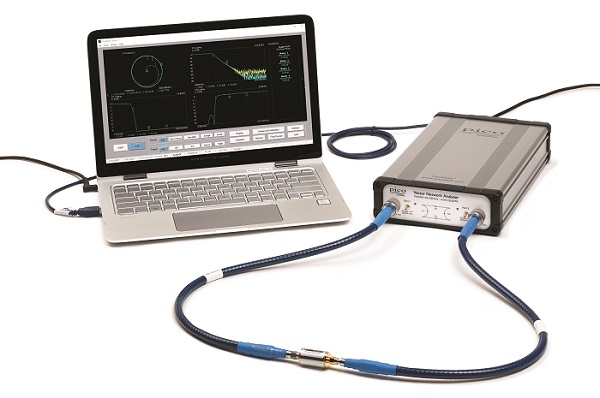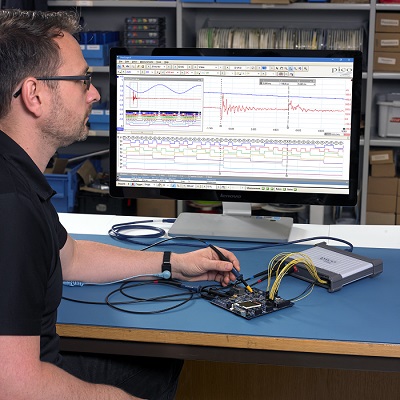
everything RF Interviewed Mark Ashcroft, RF Business Development Manager at Pico Technology Ltd., a leader in the field of PC Oscilloscopes and data loggers.
Q. Can you give us a brief history of Pico Technology?
Pico Technology has spent over 25 years leading the industry in the design, development, and manufacture of high-performance PC Oscilloscopes and Data Loggers, while engineers at our Eastern Europe office have been working in the RF and microwave market since 1974.
Q. What made you decide to enter the RF test equipment space?
Over a period of 8 years, we had built a successful position with our broadband Sampling Oscilloscopes and their attendant RF, microwave and gigabit data measurement capabilities, today out to 25 GHz. We had added optical, clock recovery and TDR/TDT network analysis capabilities, including our PG900 fast transition pulse generators. Most importantly to our forward path, we had established a global sales channel that could promote, sell and support ‘high-touch’ RF, Microwave and Gigabit test and measurement products. We also benefited from new RF instrument users in our ever growing customer and USB instrument user base and began to learn more of their needs, their problems and of course the media that they respond to. What would you do next? I guess it comes as no surprise that we would be likely to expand our USB instrumentation lines into the higher frequency markets. That specifically is my role (Mark Ashcroft – RF Business Development Manager).
Q. Can you tell us more about the RF product Line that you have? What is the roadmap for this segment?

In the last few years we have added to the RF tools portfolio the PicoVNA 106 6 GHz Vector Network Analyser, the PicoSource® AS108 8 GHz Agile Synthesiser signal generator and a comprehensive range of fully traceable calibration kits, check standards and other very necessary high-performance accessories such as test leads, port adapters and the PicoConnect range of low invasive 4 – 9 GHz passive browser probes. It’s a growing, highly portable and affordable RF, microwave and gigabit tool kit and one that we will continue to fill and develop.
Behind all of our products is the owner and managing director Alan Tong’s belief that “we should sell solution-based products to our customers at a price that we can afford”, not necessarily at a market price. We should truly “treat the customer as our friend”. Naturally, the USB control platform helps us to ensure that our products are both portable and affordable for our customers.
Q. Pico is famous for their PC-based oscilloscopes and data loggers. Can you tell us more about these products?
PicoScopes and PicoLog® data loggers are “PC based” instruments that take advantage of rapidly advancing PC processing power and display capabilities.
PicoScopes, with PicoScope® 6 software, are “Six in One” instruments: oscilloscope, logic analyzer (on MSO models) spectrum analyzer, serial bus analyzer, function generator, and an arbitrary waveform generator. There are obvious cost and space savings having those capabilities in a single compact instrument, but there are technical benefits as well, with the capability to correlate measurements from one domain to another. For example, data errors identified with the bus analyzer can be easily traced to signal integrity issues in the waveform.
PicoLog data loggers can be used to record temperature, current, voltage and virtually any other parameter with the supplied PicoLog 6 software that runs on Windows, Linux, and macOS platforms.
Q. You recently launched PicoScope 5000 Series oscilloscopes. Can you tell us more about this product?

PicoScope 5000D Series FlexRes® models employ multiple high-resolution ADCs at the input channels in different time-interleaved and parallel combinations to optimize either the sampling rate to 1 GS/s at 8 bits, the resolution to 16 bits at 62.5 MS/s, or other combinations in between. The user selects the most appropriate hardware resolution for the requirements of each measurement. PicoScope 5000D MSO models add 16 digital channels, providing the ability to accurately time-correlate analog and digital channels.
Q. Can you give us more information about the Pico VNA Series? We have seen a number of companies introduce Modular/USB Based VNA's in the last few years. What differentiates the Pico VNA from your competitors?
My personal drive to our introduction of the PicoVNA was that I had spent my whole microwave engineering and metrology career begging for, borrowing and often fixing the single most important piece of test equipment that any microwave engineer would need: a vector network analyser! Why? Because even for large corporations, the VNA was too expensive to buy, own and repair.
It probably won’t be lost upon readers that the PicoVNA and its accessories are typically half the price of its nearest competitors and a quarter to a fifth the price of many bench tops in the same frequency range. Specifications are all in fact very similar. However, the real distinguishing feature, and I have to say, the often quite un-expected distinguishing feature, is that the PicoVNA makes measurements that are at least as good, often better, and typically faster than all its competitors. It is a customer evaluation of the PicoVNA that generally makes the sale, and our conversion rate at that point in the selling process is outstanding!
Q. Up to what frequencies do your VNA's operate? Are you planning to develop products to cater to mm-Wave and 5G applications?
The PicoVNA 106 currently operates to 6 GHz and that boundary is widely recognised to be deeply 5G relevant. In fact, it covers an estimated 90% of all the measurements that will be made around 5G. A VNA, of course, doesn’t typically make protocol specific measurements. Rather, it makes physical layer measurements that ensure accurate transmission and receipt of the protocol including, in the case of the PicoVNA, amplifier compression (P1dB) and modulation mode conversion (PM due to AM). My current understanding of other prominent 5G bands are 29 GHz and 42 GHz. These are not currently target areas for Pico.
Q. All USB controlled products like the VNA & oscilloscopes are governed by software and GUI that controls them - can you tell us more about the software and GUI that you have developed?
If I’m not careful that could lead to a very long answer indeed, especially as Oscilloscopes, VNAs, and Signal Generators all have such very different needs for their graphical user and remote control interfaces, and their control software. For instance, most of our oscilloscopes are based only upon core FPGAs and do not incorporate a processor of any kind, whereas the RF product lines including the sampling oscilloscopes do include processors – perhaps a PIC through to a powerful ARM core. As you might imagine, on-instrument data processing varies from product to product, but in general, it is acquisition control, caching, transfer selection, stamping, aggregation and queuing that occurs on-instrument. In particular, Pico is noted for its very long memory oscilloscopes and hardware accelerated data organisation, where pipelining becomes critical. At the other end of the USB interconnect, USB3 is where large data transfers need to be supported; it is PC hosted software that handles everything else.
The Microsoft Windows control applications: PicoScope, PicoSample, PicoVNA, and PicoSynth present the user with comprehensive and familiar instrument controls with measurement and parameter values display. The latter via equally comprehensive post-processing such as serial data decode, automated measurements, frequency to time domain transformations (or vice versa) and familiar display formats such as data eyes, Smith charts, group delay, logic port analysis, contoured persistence, zooms and segments, mark and cursor readouts as appropriate to the hosted instrument.
Q. Can customers write their own code to control Pico products? What languages and platforms are the products compatible with? Do you provide any pre-built libraries?
An important trend that we see in the test and measurement market place is an increasingly diverse application space, most especially for the RF and microwave lines as the high-speed measurands spread their tentacles ever more into all our lives.
We all carry and if we don’t already, will shortly wear RF and gigabit signal paths. Our homes, cars, navigation, media streams, and telecoms increasingly rely upon complex high-speed signals, components, and paths that need to be measured and analysed in ever increasing and diverse detail. These signals are also probing our devices, our bodies, our food, our materials, the ground we walk on and cultivate, the spaces and skies we peer into. All these applications have very diverse needs of the signal sourced, the measurement made and the volume of data needing to be processed. It should be no surprise then that customized instrument control and post measurement analysis becomes ever more important – and off-the-peg analysis less so. Nor should it be a surprise that heavily invested and optimised automation and analysis tools grow in their importance. I think of Mathworks’ MATLAB and NI’s LabVIEW. I also think of the popular programming environments such as C, C#, Python or even spreadsheets such as Excel and its VB macros.
Pico addresses these growing needs through its software development kits and Git Hub distribution centre and via its highly respected technical support team in Asia, the U.S. and Europe. The library of code examples provided will typically bootstrap any custom automation development, and if not, our highly respected technical support team in Asia, the U.S. and Europe will advise or in many cases develop an appropriate example.
I should note for that for those requiring large data sets, our oscilloscopes boast up to 2 GS of acquisition cache (single or multiple segmented) and that the USB3 products can stream data continuously at over 300 MB/s, assuming a motherboard and SSD that can accept this average rate from the available cache.
Q. What markets do you target? What is the break up between commercial, military and academia?
It would be wrong I think to say that we target particular market segments with products that are in fact very broad purpose test and measurement tools. Segments of particular strength, given the highly portable, low cost, robust, big data, data volatile and professional and traceable tools that we offer are:
- Manufacture research, validation, production test, calibration, field installation and service
- Secure environment (research, aerospace, security),
- OEM embedded instrument (medical, materials analysis, remote monitoring, ATE, sacrificial logging)
- Automotive manufacturer and after-market
- Education and training,
- SMEs and self-employed
- Amateur & hobbyist.
Q. Are you focusing on any specific geographic regions? What is your break up of sales for within the UK and outside the UK?
Sales split would be confidential information but suffice to say that Pico Technology has a very high reach global channel with over 100 distribution and sales partners worldwide and several of the major catalogue and e-shopfront partners. As said above, Pico supports this channel from three offices in Texas U.S., Shanghai Asia and from our headquarters near Cambridge in the UK. Pico also ships direct worldwide from its very high reach web site. Our global sales and support success gained The Queen’s Enterprise Award in 2014.
 Mark Ashcroft is the RF Business Development Manager at Pico Technology Ltd. A graduate in Electrical and Electronic Engineering from The University of Bristol in the U.K.. Mark began his career nearly 40 years ago with Pye TVT (part of the Phillips corporation) in the design of broadcast Radio and TV Transmitters.
Mark Ashcroft is the RF Business Development Manager at Pico Technology Ltd. A graduate in Electrical and Electronic Engineering from The University of Bristol in the U.K.. Mark began his career nearly 40 years ago with Pye TVT (part of the Phillips corporation) in the design of broadcast Radio and TV Transmitters.
A two-part, twenty-year history in precision metrology began with Datron Instruments Ltd. in Norwich UK in 1985; at that time researching and developing solid-state voltage references for Datron’s deeply respected precision Digital Multimeters and Calibrators.
Next, he spent nine years with Gould Instrument Systems (UK) Ltd. and the design of the world’s first digital storage oscilloscopes; a role that ultimately led back to Datron–Wavetek, later becoming Fluke Calibration Ltd. Here Mark project and product managed the Oscilloscope and RF calibration product lines as well as their DC-LF calibrators, voltage references and the 8508 8.5 digit DMM.
More recently, at Pico Technology Ltd., Mark has Project managed the development of four current oscilloscope families and a new high speed manufacturing calibration system. As Business Development Manager Mark is now driving the growth of Pico’s RF and Microwave test and measurement product lines.